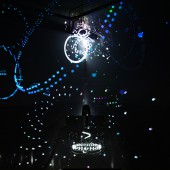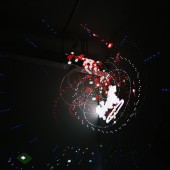DESIGN NAME:
Solar System
PRIMARY FUNCTION:
Data Driven AudioVisual Design
INSPIRATION:
Upon viewing a performance by a contemporary minimalist musician Nils Frahm, I saw the potential for the development of sonified data through the generation of pattern repetition. The musical scores composed by Frahm are comprised of several rhythms looped in repetitive sequence. While listening to his music, I realized that rhythm based sound translates well to sonified data, which composed of several different rhythms. With this idea, I attempted to create the data driven music by using Solar System data.
UNIQUE PROPERTIES / PROJECT DESCRIPTION:
Solar System is a data driven music which is made of a sidereal period data of eight planets in the Solar System. This project came from a question, What if a data driven system can be utilized as a musical instrument?. This inquiry led me to devise algorithms to generate data driven music. In terms of content, I explored how invisible Universe is able to be visible and audible existence that enables audience to have the aesthetic impression of this mysterious world of cosmos, sensing data driven content.
OPERATION / FLOW / INTERACTION:
The sidereal period of eight planets in the Solar System were used as a raw data. These relative orbit periods were transformed into eight sound loops with different cycles through being applied to algorithms in the tools. When several sound loops are played at the same time, rhythm is brought about with the repetition of sound patterns, which allow listeners to recognize music-like sound. While music is generated, the fluctuation of sound affects the visualization by transmitting the sound signal into the tool. Thus, the audiences can be mesmerized in the mysterious beauty of the planets. For the installation, A corner of a very dark room is an essential prerequisite in order to maximize the spatial effect of visualization for audience. The space resulted from the corner allows audience to recognize visualization like more 3D content due to visual illusion. By doing so, the lively generated sound and visual allow audience to be absorbed in the mysterious and honorable beauty of the Solar System.
PROJECT DURATION AND LOCATION:
The project started in winter 2015 and finished in summer 2016, Providence, RI, USA
|
PRODUCTION / REALIZATION TECHNOLOGY:
Materials: Processing, Two Computers, Ableton Live, Mic, Akai MIDI Controller, Projectors, Speakers, Solar System Data
SPECIFICATIONS / TECHNICAL PROPERTIES:
Diameter of the room 3m.
TAGS:
Data, DataSonification, Data Visualization, Data Sonification, Data Driven Content, Universe
RESEARCH ABSTRACT:
In this research, I studied data sonification in great depth, answering to my question, What if a data driven system can be utilized as a musical instrument? One of the most meaningful studies for this question is Sound Mapping that allows data to be transformed into a soundtrack from which listeners can recognize music like sound. The study led me to research the availability of data driven sound becoming a medium for increasing the aesthetic impression of audience, using the algorithmic system.
CHALLENGE:
The most compelling part of research is that the principal of data sonifcation and visualization are similar. Considering the principles of data visualization, pattern recognition is foundational. Regarding patterns of visualization, Colin Ware, an expert in the psychology of perception, mentions powerful capabilities of the human visual system for understanding patterns of data: Why should we be interested in visualization? Because the human visual system is a pattern seeker of enormous power and subtlety. The eye and the visual cortex of the brain form a massively parallel processor that provides the highest-bandwidth channel into human cognitive centers. At higher levels of processing, perception and cognition are closely interrelated, which is the reason why the words Understanding and Seeing are synonymous. Such patterns allow people to identify information through rhythmic and harmonic organization. As the principal of data visualization, several different rhythms also mathematically generate repetitive audible patterns, making harmonic organization with other rhythms. From the regularity among sound patterns, listeners may respond to this accumulation as music. Based on these experiences and discussions, I designed this project through doing different experiments to develop sonification methodologies.
ADDED DATE:
2016-10-07 05:25:49
TEAM MEMBERS (1) :
Hyemi Song
IMAGE CREDITS:
Hyemi Song, 2016.
PATENTS/COPYRIGHTS:
Hyemi Song
|










